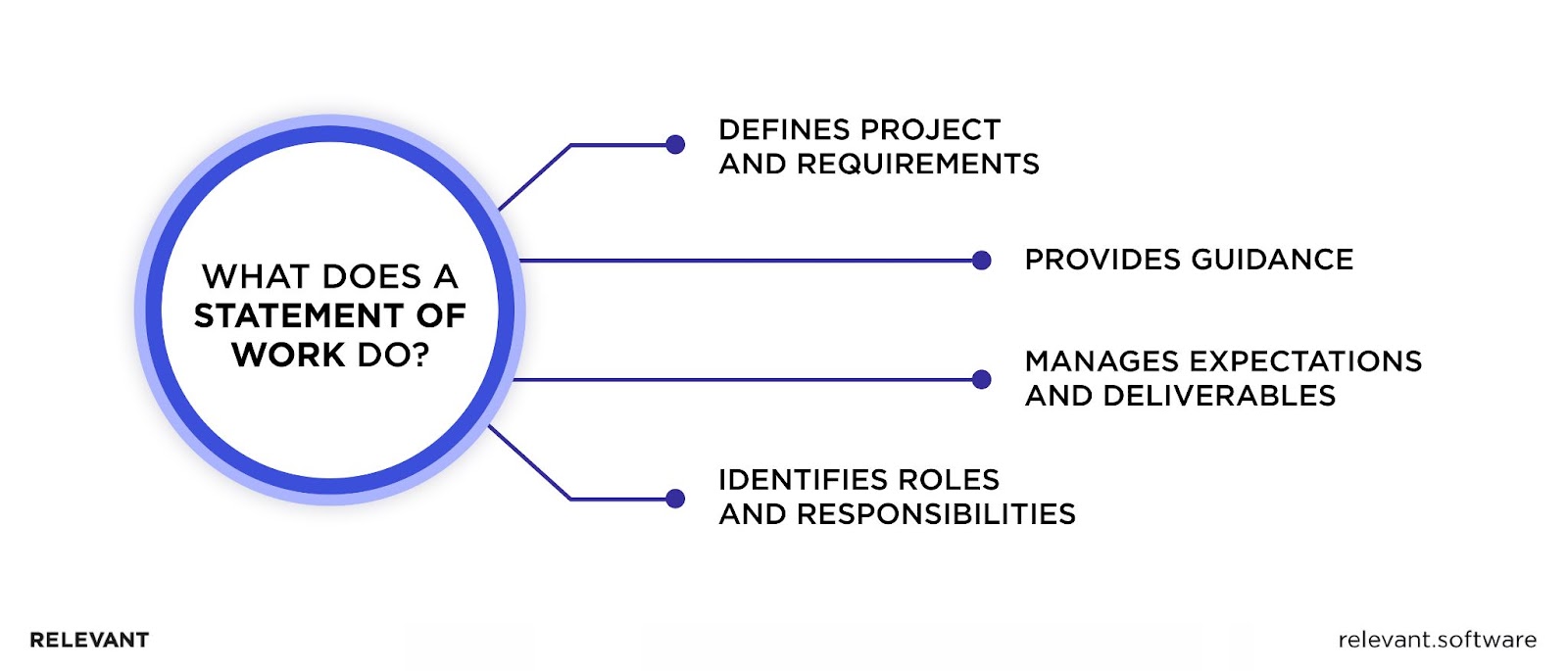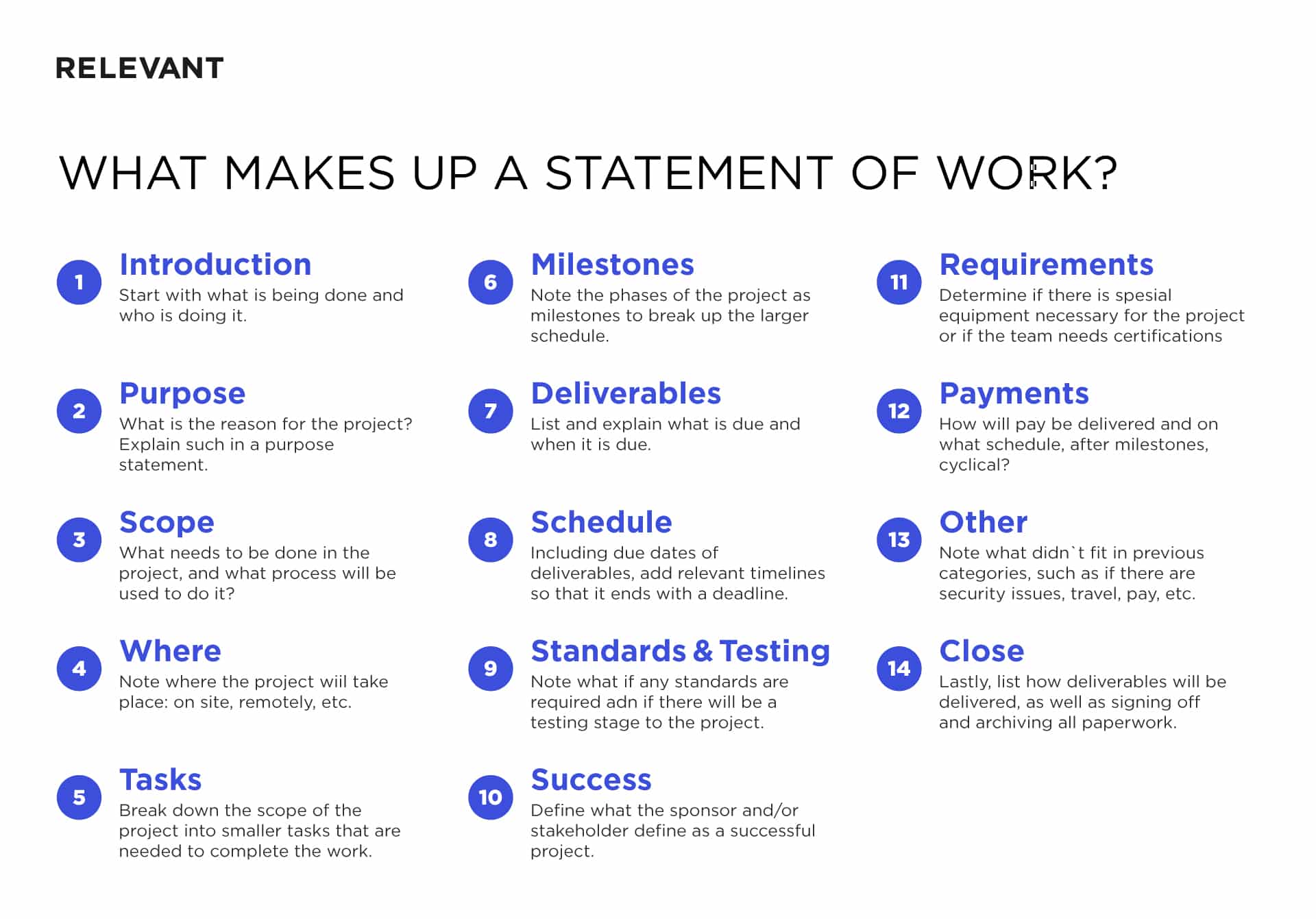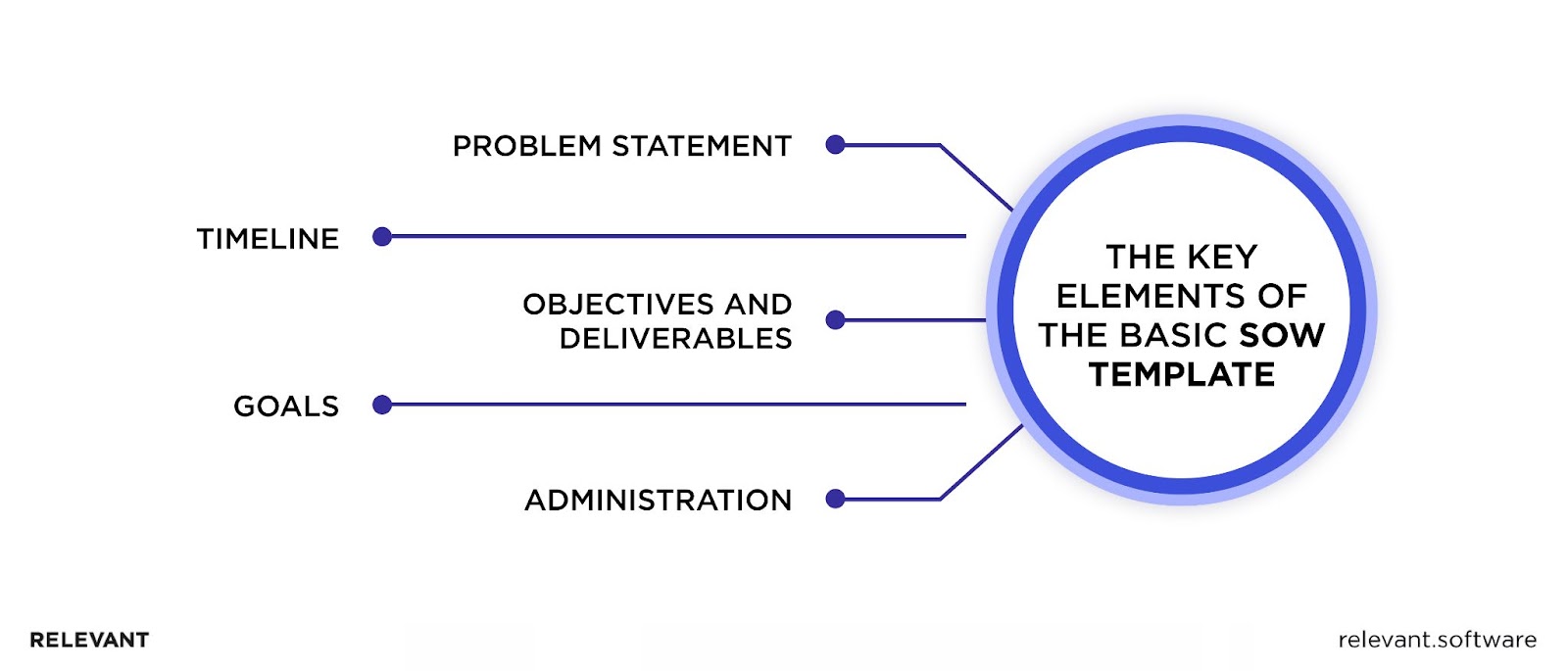Statement of Work (SOW) Document in Software Development: Everything You Need To Know
Updated: June 4, 2025
How do you maximize the chances your IT project delivers the expected value on schedule and within budget? Unfortunately, software development projects have an increased risk of cost and time overruns. Statista found that 41% of companies went over budget while carrying out their global enterprise resource planning (ERP) implementation projects.
As you can see, things may often go wrong without proper project planning. So how do you get exactly the software you need when partnering with your product development outsourcing partner? We can confidently say the Statement of Work (SOW) document is the proven way to do that.

We provide companies with senior tech talent and product development expertise to build world-class software. Let's talk about how we can help you.
Contact usSo, what is SOW development, and how can it help secure better alignment with an IT outsourcing vendor, even if it’s your first joint project? What should a good SOW include? Keep reading, and you’ll find out everything about SOW software and how to use it for effective project planning.
Table of Contents
SOW definition
To begin with, let’s define a statement of work concept. SOW meaning in software development, refers to a document that details all the contract terms between you and the service provider necessary to complete the project successfully.
An SOW document is like a meticulously crafted map that guides you and your outsourced team toward a shared goal. It’s one of the critical documents in software development that helps you establish all collaboration terms. Moreover, a good SOW also functions as a powerful project management tool that helps build trust, reducing the risk of misunderstandings that can derail even the greatest projects.

In other words, SOW is a guarantee that you get what you want as a client because it describes each aspect of the client-vendor cooperation and thus helps you:
- Synchronize the expectations of the project with an outsourcing company
- Define and fix areas of responsibility
- Minimize the risk of scope creep
- Double-check all the details to keep your project under budget and on schedule
- Ensure all stakeholders are on the same page
Purpose of Statement of Work (SOW) Document
In cooperation with a service provider, it is in your best interest to create a well-documented statement of work for software development. SOW defines what’s included in the project scope and what are the responsibilities, liabilities, and work agreements between you and your outside partner.
Typically, it contains such critical aspects as project scope, objectives, deliverables, work standards, schedule, criteria, and payment details. But you may also include specific information like project support, security-related issues, fines for poor product quality or non-compliance with the contract terms, etc.
So, the primary purpose of an SOW is to make every part of the client-vendor contract transparent to enhance cooperation and eliminate misunderstandings and disputes throughout the project lifecycle. Just imagine a journey where everyone knows the goal, the final destination, and how to get there.

Who Should Write the Software SOW
Anyone related to a project can write SOW as long as they know all the nuances of product software development. For this reason, outsourcing vendors are the ones who can prepare and deliver a high-quality statement of work for software development with detailed project information. The fact that an IT company skilled in app development and experienced in handling many of the projects makes it more qualified for the SOW creation.
There can be several co-creators of the document. So, if you or someone in your company understands technical requirements, budget details, deadlines, or acceptance criteria, engage them in the SOW document formation. They can provide valuable input and feedback.
In any case, you can rely on your IT partner to write an SOW that includes all the necessary contents and fits its purpose. For example, at Relevant, we use a custom sample of SOW for software development that helps us deliver an in-depth document for our clients.
What’s included in the SOW for software development projects
Now that we already know the SOW’s meaning and its purpose, let’s dive into the content of the SOW software contract. While the formats and styles may vary depending on the project, we recommend including the following key elements that will work for everyone.

Introduction of SOW
The beginning should contain general information about your project and its objectives. Provide project background and reference data to help a vendor understand your needs. Adding brief data about the participants of all parties involved is also crucial. Additionally, specifying the date and location of the SOW’s creation will prove its legitimacy.
Purpose (What is it, SOW?)
What is the reason for your project? Why you want to build this product is what your service provider should understand first of all. So, detail your high-level project goals, such as what you’re trying to achieve and how you plan to do it. Provide enough context that would allow someone not familiar with the project to understand what you’re developing and why. By doing so, you’ll ensure that both parties are on the same page and committed to achieving the same end result.
Scope of work and description (What is going to be done?)
Here you’ll find a step-by-step outline of the work to be done, which we divide into the concrete tasks associated with the main development phases: project discovery, design, development, and testing. If the project is extensive, it will help to split them further into smaller steps. This approach helps establish an efficient workflow while reducing the risk of scope creep.
Besides, you should ensure this section includes the following:
- Budget
- Deliverables
- Timeline and milestones
- Technical requirements
- Everyone related to the project, including stakeholders, project managers, and outsourcing team members
- Responsibilities and roles of each participant
- Security, risk assessment, and mitigation strategies
- Conditions about possible issues
- Specifications and limitations
Location of Operations (Where will it be done?)
Considering offshore and nearshore software development have become popular outsourcing models, indicating the place and time of execution becomes especially relevant. Working with a remote dedicated team means software developers may operate from different countries and time zones. Detail this information to arrange effective communication and interaction settings with an outsourcing team.
SOW Standards (How will it be done?)
This paragraph focuses on the technical part of the project execution, which should specify the following:
- Programming languages and frameworks
- Software development industry standards
- Testing standards
- Hardware and software required for the development and testing
- Tools and platforms for communication and project management
- Protocols for alterations in the development process
- Penalties for late or poor execution and bonuses for extra work hours
Having all this data highlighted in an SOW document will help prevent costly mistakes and set the foundation for a successful partnership.
Deadlines and Schedule (When is it going to be done?)
Making this part of SOW development precise and clear guarantees you to complete the project on time and within budget. Setting a project timeline, including start date, duration, deadlines, and finish date, will help ensure stressless project delivery.
Beyond that, a detailed list of tasks and clear milestones with deadlines for each project phase will simplify monitoring and reporting progress, ensuring the project stays on track. All this will allow you to review the development process, evaluate performance, and control the project. Additionally, here you can specify the contract’s duration and the number of billable hours of your development team to ensure your project stays within budget and on schedule.
Monitoring of SOW (How to control it?)
Having some level of control over the software development process is standard practice. But what level of involvement are you comfortable with? Decide how often you would like to have meetings, calls, and reviews to track the progress. Also, you may ask your team to use applications for project management or time tracking for better control. And don’t forget to consider the reporting mechanisms and tools you want your provider to utilize for effective performance tracking.
Acceptance Criteria (How will we know the job is done?)
Another critical aspect of a software development project to include in the SOW document is defining the criteria to measure success or failure. So, you should clearly state the requirements for the completed tasks and the end product you will accept and pay for.
Also, use this section to mention the circumstances under which you, as a client, can close the contract without paying the whole amount due to unsatisfactory performance. In the end, ensure this document clause is clear to everyone. Accurately defining these criteria may save you from extra expenses in case of unforeseen circumstances.
Contract Mode and Payment Model (What does the payment process look like?)
Don’t overlook the importance of the payment details to avoid unpleasant situations with your vendor later on. There are two most popular payment models in software development outsourcing, the choice of which will depend on the project’s type and scope:
- Project-based model is best suited when you have a clear project vision, detailed requirements, and tight deadlines. The implementation of the entire project is the responsibility of the service provider, and the involvement of your team is minimal. Yet, this model limits your control over the project and processes and lacks flexibility. As for payment, it’s a fixed price model where you pay upon an agreed schedule or a full amount after the project is completed, helping you avoid overpayment.
- A dedicated team model is the most beneficial for complex, long-term projects without clear requirements and scope of work, like DevOps software development services. You’ll find it more efficient in terms of flexibility in adjusting project requirements and features during development as well as better control over the team. In this model, you’ll pay monthly for the time software engineers spend working on your project.
Whatever payment model matches your needs, it requires the agreement of all parties of the project here.
Miscellaneous (What else should we clarify?)
Bear in mind that SOW software should describe your IT project in all its dimensions. So, in this section, you can clarify any moments relevant to your project that isn’t covered in the categories listed above. Depending on your project, some additional information you might include:
- Security standards and regulations
- Code ownership
- Software development team structure
- Post-project support
- Final administrative details
- Liability limits and warranties
This information in the statement of work software project lets you clarify any concerns that may undermine fruitful partnerships and the quality of the product.
Statement of Work (SOW) Templates
A properly written SOW document will increase confidence in the collaboration. However, creating it is a daunting task due to a large amount of detail it needs to include. And as we mentioned, most of the time, it’s a service provider who creates the document.
Nevertheless, we would like to give you an idea of what an SOW looks like. Moreover, all projects are unique, so you may want to write the document internally. For this reason, to
help you save time and speed this process up, here’s a free statement of work template. It will also help you avoid missing critical information about your project. So, download it and feel free to adapt it to your needs.

Different types of SOW templates
While the differences between the SOW document types are minimal, selecting one of the three basic template types will depend on your industry and project.
- Design or detail SOW provides an accurate description of requirements, ways the vendor must perform the work, and processes to follow. It depicts precise instructions on how to do the work, what materials to use, measurements, quality control requirements, and more. Since a software development company has to pursue specific requirements laid out for them, you, as a client, take most of the risk.
- Level of effort SOW focuses on hourly service fees and materials necessary to complete the work. So, all it describes is the service you require over a set amount of time.
- Performance-based SOW provides the most flexibility. It clearly lays out the project’s purpose, the equipment, and the resources provided. This SOW document prioritizes performance rather than the way the service is completed. That’s why it gives project managers the autonomy to decide how to arrange the project development process.
Summary
An SOW document is valuable for any company embarking on a new project. It’s a cornerstone of efficient collaboration that helps you navigate the intricacies of digital product development and achieve your goals. The document comprises all the information securing a trustworthy and pleasant partnership. Moreover, with a decent SOW, you will be equipped enough to complete the project on time, in scope, and within budget.
At Relevant, we’re always very careful with preparing a statement of work for software development and its agreement with our clients. That’s why we have so many clients satisfied with our work. So contact us to be one step closer to bringing your project to life in record time.
FAQ
Our core services:
Do you want a price estimate for your project?
Do you know that we helped 200+ companies build web/mobile apps and scale dev teams?
Let's talk about your engineering needs.
Write to us











